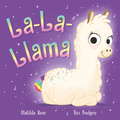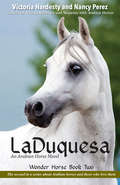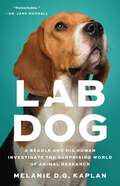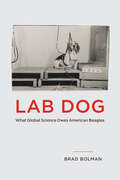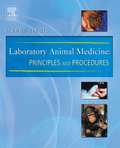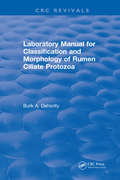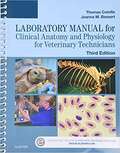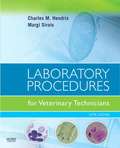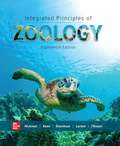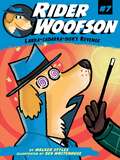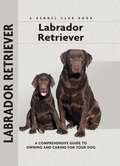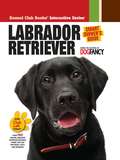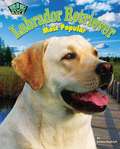- Table View
- List View
La última sirena
by Eva Millet Romy BerntsenLa última sirena, merecedora del Premio Boolino 2018, es una historia fascinante sobre la amistad, la magia del mar, y todo lo que un verano puede cambiar nuestras vidas. Clara es una niña de once años cuya frenética vida entre escuelas de élite, múltiples extraescolares y fines de semana siempre planificados se corta en seco debido a una grave crisis familiar. Al llegar el verano, Clara se ve obligada a renunciar a los campamentos a los que van sus amigas y a pasar el verano entero con sus tíos abuelos, a quienes apenas conoce, en una pequeña isla del Mediterráneo en la que nunca pasa nada. Pero poco a poco Clara se da cuenta que ni sus tíos ni la isla en la que residen son tan apacibles y amables como parecen. ¿Qué extraña enfermedad hace que su tía Esmeralda, una bellísima mujer postrada en silla de ruedas, languidezca día a día? ¿Por qué el tío Juan se muestra cada día más hostil con Clara? ¿De dónde provienen los cantos que se oyen cada noche y...¿ quién es la misteriosa joven que nada al amanecer en la playa?
La-La-Llama (The Magic Pet Shop #2)
by Matilda RosePrince Leo is a shy, quiet prince. But Mrs Paws has just the pet for him . . . La-La-Llama: a magical llama with the power of song!There is going to be a talent competition in Twinkleton-Under-Beanstalk. All Prince Leo's friends are entering - and they want Leo to join them. Prince Leo doesn't want to say no . . . but he's terrified of performing in front of so many people! Can Leo overcome his nerves and find his voice . . . with some help from La-la-llama?From the creators of Pugicorn comes a magical and fun-filled story with a super sparkly glitter cover! Discover other books in the Magic Pet Shop series:PugicornPugicorn and the Christmas WishStarwhalPandarina
LaDuquesa: An Arabian Horse Novel
by Victoria Hardesty and Nancy PerezLa Duquesa wanted her “one and only” human for as long as she could remember. Maryann Wilcox dreamed about riding a silvery mare bareback across a meadow in the moonlight since she could remember. A tragedy introduced them to each other, but circumstances kept them apart. Maryann's riding instructor, Ginny Hartley, could see the connection between the rescued horse and the young girl who lived in poverty. Ginny began pulling strings trying to unite a broken family, so she could unite that special horse with her special girl.
LaRue Across America: Postcards from the Vacation
by Mark TeagueBestselling, award-winning author/illustrator Mark Teague makes readers laugh aloud when LaRue goes on vacation with Mrs. Hibbins's cats! Ike's plans for a peaceful cruise with Mrs. LaRue are thwarted when their neighbor, Mrs. Hibbins, falls suddenly ill from heat stroke. Mrs. LaRue suggests that she and Ike care for her cats while Mrs. Hibbins is in the hospital, inviting them along on the cruise. But cats aren't allowed, and Mrs. LaRue decides to take them all on a week's vacation of road-tripping. Ike begs and begs for bus fare in his letters to Mrs. Hibbins, but why does she not respond? Image descriptions present.
Lab Dog: A Beagle and His Human Investigate the Surprising World of Animal Research
by Melanie D.G. KaplanThe "remarkable" (Dr. Jane Goodall) story of a beagle&’s past, and the future of animal research When journalist Melanie D.G. Kaplan adopted her beagle Hammy, all she knew was that he had spent nearly four years in a research lab. Curious to know more about this gentle creature&’s past, as well as the broader world of animal research, Kaplan—with Hammy in tow—embarks on a quest for answers. How did Hammy end up in a research facility? Why are we still using millions of animals a year in experiments? What have we learned from them? Is there another way? In Lab Dog, Kaplan investigates the breeding and use of beagles for biomedical research, drug and product testing, and education. She takes readers on a journey, peeking behind laboratory doors and visiting with researchers, activists, ethicists, veterinarians, lawmakers, and innovators. Along the way, she finds thoughtful and caring humans on all sides of the debate, explores promising developments in nonanimal testing, and discovers puzzle pieces from Hammy&’s past. Equal parts journalism and love story, Lab Dog offers a nuanced view on our relationship with a species that we both love and exploit, and a reason to hope for a better future for all.
Lab Dog: What Global Science Owes American Beagles
by Brad BolmanTracing over a century of transformation in the relationship between humans and our “best friend,” from hunting companion to laboratory commodity to modern pet. Intrepid, docile, and cloaked in coats of white, black, and tan, beagles were one of the most popular breeds in the United States in the twentieth century. From Snoopy to dog shows, many Americans loved and identified with beagles. But during the same period, as scientists searched for a standard research dog, beagles emerged as something else: an ideal animal for laboratory experimentation. In Lab Dog, historian Brad Bolman explains how the laboratory dog became a subject of intense focus for twentieth-century scientists and charts the beagle’s surprising trajectory through global science. Following beagles as they moved from eugenics to radiobiology, pharmaceutical testing to Alzheimer’s studies, Lab Dog sheds new light on pivotal stories of twentieth-century science, including the Manhattan Project, tobacco controversies, contraceptive testing, and behavioral genetics research. Bolman shows how these experiments shaped our understanding of dogs as intelligent companions who deserve moral protection and socialization—and in some cases, daily medication. Compelling and accessible, Lab Dog tells the thorny story of the participation of beagles in science, including both their sacrifices and their contributions, and offers a glimpse into the future of animal experimentation.
Laboratory Animal Medicine: Principles and Procedures
by Margi SiroisComprehensive coverage of a variety of topics such as animal species, the laboratory setting, regulatory guidelines, and ethical considerations prepares readers for a career in laboratory animal medicine. Familiarizes readers with the handling, behavior, nutrition, and lab and treatment procedures for a large variety of common and nontraditional laboratory animals. The consistent organization of each species chapter makes it easy for readers to quickly identify similarities and differences among various laboratory animals. Laboratory exercises are included in a perforated section at the end of the book, allowing users to apply their knowledge and develop job skills. Features a wealth of user-friendly features such as a two-color design, learning objectives, key points, and review questions. Provides detailed information on specific legal and ethical requirements of lab animal care and use, including the ethics of pain management. Convenient boxes and tables provide quick access to,important anatomic and physiologic data for each species.
Laboratory Animal and Exotic Pet Medicine
by Margi SiroisLearn the veterinary technician's role in the care of exotic pets and animals used in biomedical research! Laboratory Animal and Exotic Pet Medicine: Principles and Procedures, 3rd Edition helps you gain the knowledge and skills needed to ensure animal health and well-being. It covers animal husbandry, restraint and handling, and diseases, and provides guidelines to key clinical procedures such as blood collection, medication administration, anesthesia, and diagnostic imaging. Research-related information addresses the ethical concerns of exotic pet ownership, as well as the benefits and humane use of animals in research. Written by noted veterinary technology educator Margi Sirois, this text is a must-have resource for all caretakers of lab animals. Comprehensive coverage prepares you to work with all types of animals by addressing a wide variety of species including rats, mice, rabbits, guinea pigs, ferrets, hamsters, gerbils, nonhuman primates, amphibians, fish, reptiles, birds, farm animals, and cats and dogs; it also covers topics such as animal species, the laboratory setting, regulatory guidelines, and ethical considerations. Consistent organization of each species chapter makes it easy to quickly identify similarities and differences among various laboratory animals. Current information on legal, moral, and ethical issues includes legal requirements, the protocols guiding lab animal use, animal exploitation, and animal rights. Discussion of specific uses for each species in biomedical research provides a perspective that helps you explain the benefits of animal use in providing high-quality research data. Technician Notes highlight important points and provide helpful tips to improve your knowledge and skills. Learning objectives, key points, and chapter review questions make studying easier. NEW! Comprehensive coverage of poultry includes the increasingly popular backyard chickens, as well as commonly performed procedures and in-depth information on housing, restraint, nutrition, common diseases, diagnostics, and therapeutics. NEW photographs show the latest technology available in laboratory and exotic animal medicine.
Laboratory Manual for Classification and Morphology of Rumen Ciliate Protozoa
by B.A. DehorityThe only rumen protozoa lab guide featuring line drawings created by a leading scientist in the fieldLaboratory Manual for Classification and Morphology of Rumen Ciliate Protozoa is a unique lab guide for learning how to count and identify rumen protozoa. In this guide, Professor Dehority has created line drawings of rumen protozoa that emphasize morphological features and size measurements. The book also provides keys for identifying genera and species, and it contains classifications and descriptions of the different orders and families of rumen ciliate protozoa. Procedures for counting rumen protozoa and identifying individual species are included as well.Laboratory Manual for Classification and Morphology of Rumen Ciliate Protozoa will be an excellent identification guide for protozoologists, microbiologists, dairy scientists, and any researcher or student working with rumen protozoa.
Laboratory Manual for Clinical Anatomy and Physiology for Veterinary Technicians
by Joanna M. Bassert Thomas ColvilleLearn to apply your A&P learning in the lab setting with Colville and Bassert’s Lab Manual for Clinical Anatomy and Physiology for Veterinary Technicians, 3rd Edition. This practical laboratory resource features a variety of activities, such as crossword puzzles, , terminology exercises, illustration identification and labeling, case presentations, and more to help reinforce your understanding of veterinary anatomy and physiology. The lab manual also features vivid illustrations, lists of terms and structures to be identified, and step-by-step dissection guides to walk you through the dissection process. <P><P> Clinically-oriented learning exercises help readers become familiar with the language of anatomy and physiology as you identify structures and learn concepts. Clear step-by-step dissection instructions for complex organs such as the heart familiarize readers with the dissection process in a very visual, easy-to-understand format. Learning objectives, the clinical significance of the content, and lists of terms and structures to be identified appear at the beginning of each chapter. Comprehensive glossary appears at the end of the lab manual and provides accurate, concise. High quality, full color illustrations provides a firm understanding of the details of anatomic structure. Review activities and study exercises are included in every chapter to reinforce important information. Clinical Application boxes are threaded throughout the lab manual and demonstrate the clinical relevance of anatomic and physiologic principles. Companion Evolve site includes answers to the Test Yourself questions in the textbook and crossword puzzles. NEW! Overview at a Glance sections outline the main proficiencies of each chapter and include a list of all exercises in the chapter.
Laboratory Manual for Clinical Anatomy and Physiology for Veterinary Technicians
by Joanna M. Bassert Thomas P. ColvilleLearn to apply your A&P learning in the lab setting with the Laboratory Manual for Clinical Anatomy and Physiology for Veterinary Technicians, 4th Edition. This practical laboratory resource features a variety of activities, such as terminology exercises, illustration identification and labelling, case presentations, and more to help reinforce your understanding of veterinary anatomy and physiology. The laboratory manual also features vivid illustrations, lists of terms and structures to be identified, and step-by-step dissection guides to walk you through the dissection process. <p><p> Clinically oriented learning exercises introduce you to the language of anatomy and physiology as you identify structures and learn concepts. <p><p>Clear, step-by-step dissection instructions for complex organs such as the heart familiarize you with the dissection process in a very visual, easy-to-understand format. <p><p>Learning objectives, the clinical significance of the content, and lists of terms and structures to be identified appear at the beginning of each chapter. <p><p>Review activities and study exercises are included in every chapter to reinforce important information. <p><p>High-quality, full-color illustrations provide a solid understanding of the details of anatomic structure.
Laboratory Procedures for Veterinary Technicians (5th edition)
by Charles M. Hendrix Margi SiroisFive American academics contribute nine chapters to an updated text for practicing veterinary technicians, veterinary assistants, and veterinary technology students. The text covers principles and procedures for laboratory diagnostics in the areas of clinical chemistry, microbiology, hematology, homeostasis, parasitology, urinalysis, immunology, and cytology. It assumes a basic understanding of the anatomy and physiology of common species. The new edition has been significantly updated with expanded information reflecting the latest developments in the veterinary clinical laboratory since publication of the 2002 edition. It includes new sections on laboratory mathematics, hematopoiesis, molecular diagnostics, and the physiologic basis of immunity; expanded information on clinical analyzers and quality assurance; and information on professional associations related to veterinary clinical pathology. Illustrated with full color and b&w photomicrographs, charts, and diagrams. Annotation ©2008 Book News, Inc., Portland, OR (booknews.com)
Laboratory Procedures for Veterinary Technicians - Elsevier on VitalSource
by Charles M. Hendrix Margi SiroisClearly presents the fundamentals of microbiology, hematology, urinalysis, immunology, parasitology, and cytology along with the laboratory procedures used to perform tests in these fields.Features the latest information on the most widely used tests, including complete blood count, urinalysis, and immunology assays.Features step-by-step procedure boxes, for quick mastery of essential skills.Extensive full-color illustrations enhance descriptions of normal and abnormal findings.New co-author Margi Sirois is a respected author and renowned speaker on laboratory procedures, particularly clinical pathology.Now in full-color with hundreds of vivid illustrations that demonstrate key concepts.New smaller size is more convenient and portable.Features expanded sections on laboratory safety and quality control, all routine CBC and coagulation tests, serum chemistry tests, electrolyte and endocrine function testing, innate and adaptive immune systems, bone marrow evaluation, and cytology sample collection and handling.New sections include the formation of blood cells, histograms produced by automated cell counters, bacterial and fungal morphology, microorganisms, molecular diagnostics, radioimmunoassay and fluorescent antibody (FA) testing, the physiology of immunity, and algorithms for the evaluation of cytology samples.Dozens of new chemistry, hematology, and microbiology boxes and tables synthesize essential information.Key Points summarize important concepts for quick review.
Laboratory Studies In Integrated Principles Of Zoology
by Allan Larson Cleveland P. Hickman Larry S. Roberts Helen I'AnsonLaboratory Studies in Integrated Principles of Zoology textbook.
Laboratory Techniques for Fish Disease Diagnosis
by Vikash Kumar Basanta Kumar DasThis book covers various aspects of fish health, disease identification and laboratory procedures. Each section of the book is detailed and includes practical information, step-by-step procedures and relevant illustrations and diagrams. The recent updates on fish disease diagnosis have been incorporated to address new techniques and technologies in the field. Fish disease diagnosis is primarily based on the color and characteristics in the image to target the infected area. It is an indispensable part of modern aquaculture, and rapid and real-time diagnosis is an essential part of the early and precise treatment of the diseases. As farmed fishes are affected by viruses, bacteria, parasites, metal pollution, and fishing damage, accurate disease diagnosis is crucial for effective management interventions. It often requires a combination of clinical expertise, advanced technology, and collaboration among healthcare professionals. This book is a comprehensive guide for students, researchers and professionals involved in fish disease diagnosis.
Laboratory Urinalysis and Hematology for the Small Animal Practitioner
by Carolyn Sink Bernard FeldmanThe main goal of this book is to provide an easily readable and accessible guide which we hope will be readily found on the laboratory bench and will be constantly open and used.
Labra-cadabra-dor's Revenge
by Walker Styles Ben WhitehouseThe tricky magician Labra-cadabra-dor puts Rider under a spell in this seventh Rider Woofson adventure.When the tricky Labra-cadrabra-dor breaks out of prison, Rider gears up to face his old nemesis. But this time Labra-cadabra-dor is one step ahead and zaps Rider under an evil spell. Will Rora and the PI Pack be able to uncover the secret behind the magic trick before the act is over? With easy-to-read language and illustrations on almost every page, the Rider Woofson chapter books are perfect for emerging readers.
Labracadabra
by Hopkins Jessie Nelson Karen LeighZach isn't impressed with his new dog, Larry, at first. He'd hoped for a chocolate lab or a spaniel, not this funny looking mish-mash of a dog with a great long tail. And who names a dog "Larry," anyway? But Zach discovers that when Larry twirls that ridiculously long tail - Labracadabra! - amazing things happen. It's not very long before Zach knows that he and Larry will be Best Friends Forever! .
Labradoodle
by Mary Bloom Miriam Fields-BabineauA Designer Dog book dedicated to the world's most popular crossbred, Labradoodle celebrates the "breed" created from the pairing of a Poodle and a Labrador Retriever. Professional animal trainer and author Miriam Fields-Babineau presents a look at the origins of both parent breeds as well as a glance at the unique nature of a Doodle-the special characteristics of the Labradoodle that combine the best traits of both parent breeds. The book includes the International Labradoodle Association's standard for the Labradoodle as well as chapters on feeding, grooming, house-training and obedience. The final chapter of the book "Experience Labradoodle Fun" talks about all of the fun activities for owners and their Doodles, including agility, flyball, dancing with dogs, and more.
Labradoodles (Complete Pet Owner's Manuals)
by Joan Hustace WalkerAn essential guide for choosing, preparing for, raising, and training a healthy, well-behaved Labradoodle puppy or dog.While Labradoodles first came into existence when a breeder sought a service dog with the low-shedding coat of a poodle and the gentleness and trainability of a Labrador Retriever, Labradoodles have gone on to become a beloved member of the family for thousands of households.Learn tips and practical advice on:Housing and preparing for the arrival of your pupBasic care, including health care, nutrition, and groomingBehavior and characteristics common to the doodlePositive, reward-based training methodsWhether you're a new, first-time dog owner or want to brush up on your puppy-raising skills, The Complete Pet Owner's Manual on the Labradoodle has everything you need to make life with your delightful, funny, and smart dog comfortable and enjoyable—for you and the dog alike.With beautiful color photography, this also makes a great gift for Labradoodle lovers and owners!
Labrador Retriever
by Margaret A. GilbertThe experts at Kennel Club Books present the world's largest series of breed-specific canine care books. Each critically acclaimed Comprehensive Owner's Guide covers everything from breed standards to behavior, from training to health and nutrition. With nearly 200 titles in print, this series is sure to please the fancier of even the rarest of breeds.
Labrador Retriever (Breeders Best, A Kennel Club Book)
by Bauer KilgoreWhether you are seeing yellow, black or chocolate in your future, Breeders' Best Labrador Retriever promises to be a colorful and informative start for the first-time owner. Here is precisely what the new owner needs to know about life with a Labrador Retriever. From how to select a top-rate breeder and recognize a sound, healthy puppy to caring for and training the puppy, the author guides you every step of the way. Author Nona Kilgore Bauer, a celebrate authority on retrievers, offers sensible, helpful advice about house-training, sensible obedience training and effective problem solving, as well as responsible home care, health and veterinary concerns. This Breeders' Best book promises the best possible start with your new Labrador puppy.
Labrador Retriever (Smart Owner's Guide)
by Dog Fancy MagazineDedicated to the most popular dog in the world-a sporting dog with no equal and a companion above all else--the Labrador Retriever, this Smart Owner's Guide, created by the editors at Dog Fancy magazine, offers the most up-to-date and accurate information every dog owner needs to become a well-informed caregiver for his dog.<P><P> Illustrated with color photographs of adorable puppies and handsome adults, this easy-to-read primer is designed in a modern, lively manner that readers will find user-friendly and entertaining.Each Smart Owner's Guide offers a description of the breed's character and physical conformation, historical overview, and its attributes as a companion dog. The reader will find informative chapters on everything he or she needs to know about acquiring, raising, and training this remarkable purebred dog, including: finding a breeder and selecting a healthy, sound puppy; preparing for the puppy's homecoming, shopping for supplies, and puppy-proofing the home; house-training; veterinary and home health maintenance; feeding and nutrition; and grooming. Obedience training for basic cues (sit, stay, heel, come, etc.) and solving potential problem behaviors (barking, chewing, aggression, jumping up, etc.) are addressed in separate chapters, as are activities to enjoy with the dog, including showing, agility, therapy work, and more.Entertaining tidbits and smart advice fill up colorful sidebars in every chapter, which the editors call "It's a Fact," "Smart Tip," "Notable & Quotable," and "Did You Know?" Real-life heroes and rescue stories are retold in full-page features called "Pop Pups" and "True Tails." Recipes, training, and care tips are highlighted in the "Try This" feature pages.The Smart Owner's Guide series is the only series that offers readers an online component in which dog owners can join a breed-specific online club hosted by dogchannel.com. At Club Lab, owners of the breed can find forums, blogs, and profiles to connect with other breed owners, as well as charts and checklists that can be downloaded. More than just 20,000 pages of solid information, there's a host of fun to be had at the club in the form of downloadable breed-specific e-cards, screensavers, games, and quizzes.The Resources section of the book includes contact information for breed-related organizations and rescues, as well as practical guidance on traveling with dogs, identification, and locating qualified professionals to assist the dog owner, such as pet sitters, trainers, and boarding facilities. This information-packed Smart Owner's Guide is fully indexed.
Labrador Retriever: Most Popular (Big Dogs Rule!)
by Jessica RudolphDiscusses Labrador retrievers as search and rescue dogs, their history and appearance, training these dogs, and Labrador retrievers as pets.
Labrador Retrievers (Complete Pet Owner's Manuals)
by Joan Hustace WalkerEverything you need to know about choosing, training, and caring for your Labrador Retriever puppy or dog.Labrador Retrievers are America's favorite dog breed for a reason: they're friendly, athletic, lovable, even-tempered, and eager to please, making them the perfect family dog, hunting companion, guide dog, and more. Packed with color photos and invaluable advice, The Complete Pet Owner's Manual for Labrador Retrievers is a great resource for first-time or inexperienced pet owners.You'll learn:What makes a Lab such a great family dog and how to choose the right one from a breeder or rescueNutrition and basic care for raising a healthy LabHealth issues commonly found in LabsHow to use positive, reward-based training and socialization methods to raise a confident, well-behaved pupAlso makes a wonderful gift for the Lab lover in your life!

